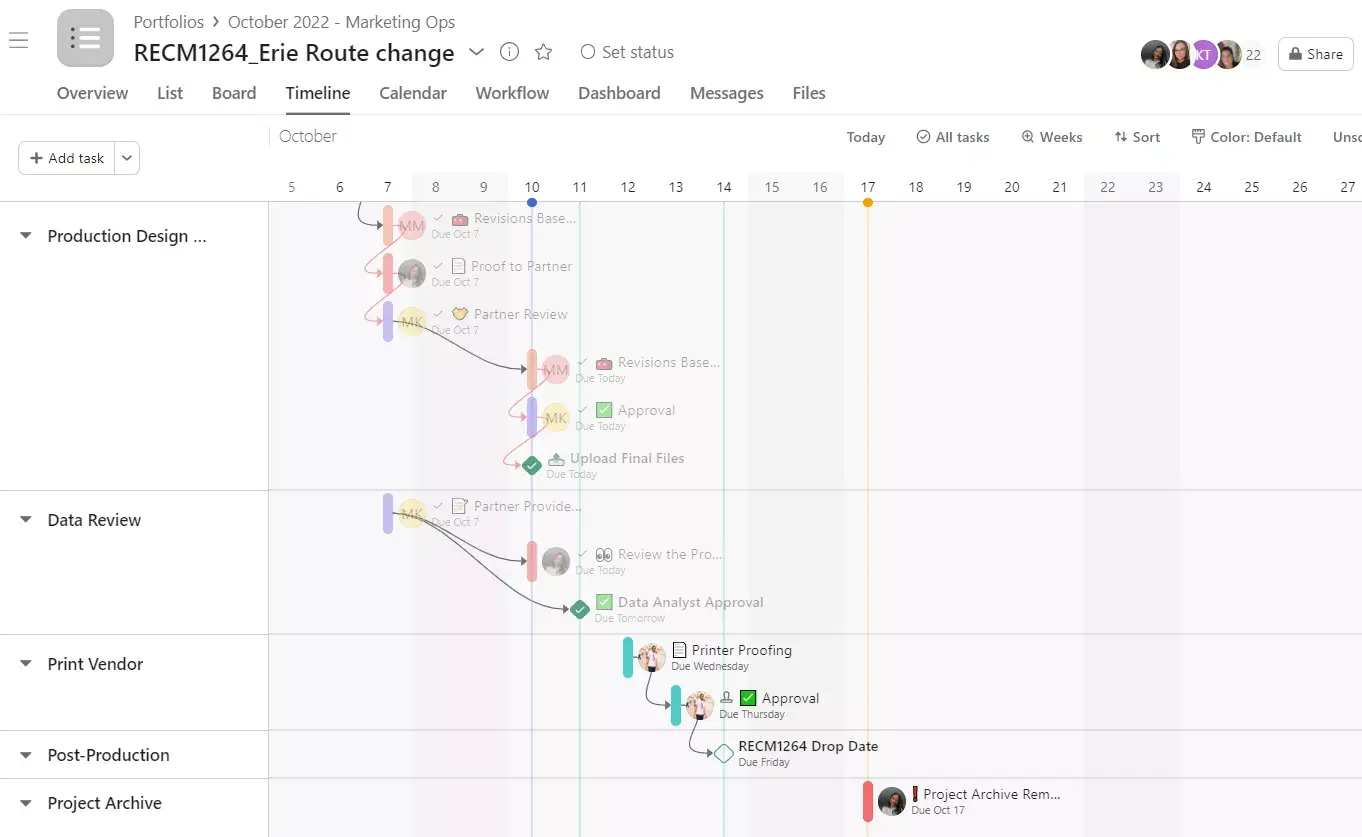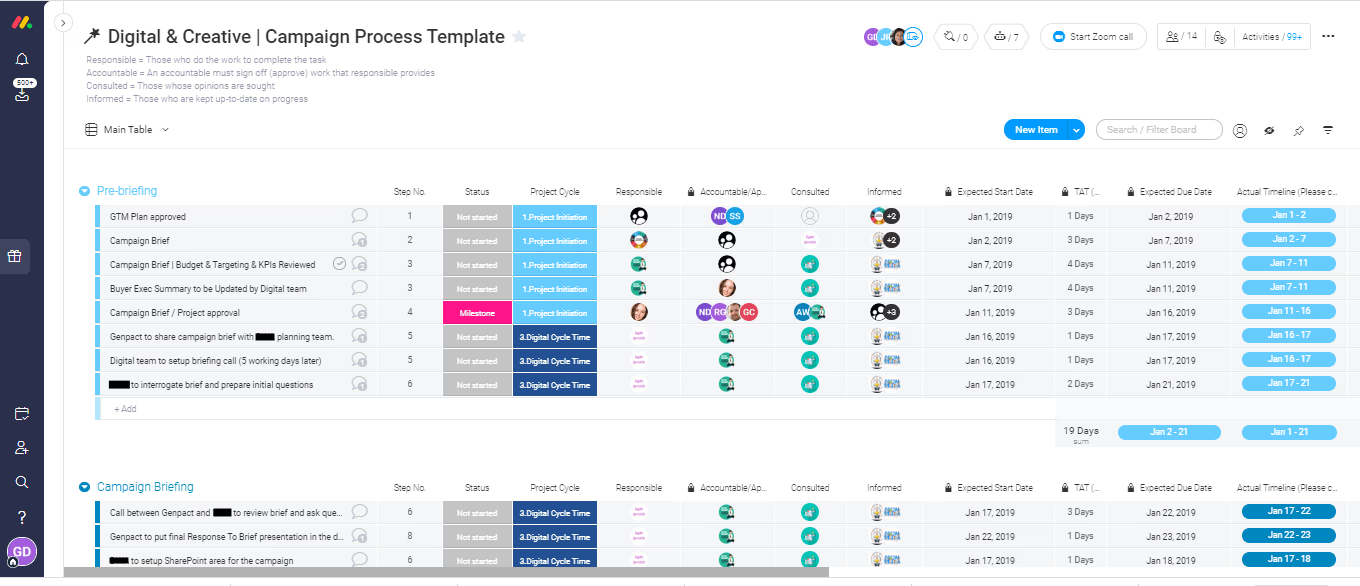Use Proper Tools to Protect Your Bottom Line:: With organizations losing millions of dollars to poor project management, you can't afford haphazard organization. Deploy the right tools and frameworks to track progress, manage resources, and keep projects profitable.
Build Transparency into Your Process: : Drive better results by creating visible project dashboards, conducting regular team huddles, and developing standardized templates. When teams can see project status and performance in real-time, they make better decisions and avoid costly mistakes.
Break Down Silos for Better Results:: Establish centralized communication channels and co-planning sessions across departments. Teams that share information freely and plan together execute campaigns faster and more effectively than those working in isolation.
For the thousands of startups struggling to bring order to a chaotic marketing workflow, marketing project management isn't just a nice-to-have efficiency boost—it's key to their business's growth and survival.
The numbers tell a troubling story: less than half of marketing team members say they understand what their colleagues are working on at any given time (Project.co's Project Management Statistics, 2021).
Without proper project management, marketing teams face serious problems: missed deadlines, wasted resources, and team burnout. But with the right approach, the transformation can be remarkable. For example, the marketing ops team at Gannett, a publisher, more than doubled their campaign capacity and saved nearly 400 workdays through better project management (Asana case study on Gannett).
In this marketing project management guide, you'll learn the:
- Exact frameworks
- Tools
- And strategies that successful marketing teams use to manage their projects.
Whether you're struggling with scope creep, resource allocation, or stakeholder alignment, you'll find practical solutions backed by real-world examples.
What Is Marketing Project Management?
Marketing teams are struggling with project management—and it shows. Only 27% of marketers report being very happy with how their teams manage projects.
This subpar performance comes at a steep cost: organizations lose $109 million for every $1 billion invested in projects and programs.
So what exactly is marketing project management? Productivity strategist Theresa Cifali defines it like this:
Unlike traditional project management, marketing projects require unique considerations—from creative workflows and rapid iteration to cross-channel coordination and performance tracking.
Marketing project management requires three key parties to work together:
- Internal stakeholders (team members, departments, and leadership)
- External stakeholders (clients, vendors, and partners)
- The marketing project manager, who coordinates across all groups
When done right, marketing project management can transform how your team works.
Meghan Monaghan, a digital marketing strategist, says that successful marketing project management allows teams to "handle multiple tasks seamlessly, communicate effectively, meet deadlines, and ensure the alignment of marketing goals with overall business objectives."
5 Key Phases Of Marketing Project Management
Marketing project management follows a structured lifecycle that guides initiatives from conception to completion. Let's explore each phase, starting with the critical initiation stage.
Phase 1: Initiation—Defining Scope and Objectives
Many marketing projects are doomed before they even begin. According to Harvard Business Review, projects fail for two common reasons: either they "bite off more than they can chew and thus grossly underestimate time and money" or "a significant part of the work has been overlooked." To avoid these pitfalls, successful marketing teams use tools like the Work Breakdown Structure (WBS) to subdivide complex activities into manageable units.
Here's how to create a WBS for your marketing initiatives:
- Start by asking, "What will have to be done in order to accomplish X?"
- Continue breaking down activities until you reach tasks that cannot be subdivided further
- Estimate task duration, required resources, and costs in terms of both dollars and person-hours
But even with careful planning, scope creep can threaten project profitability. Joe Knight, Roger Thomas, and Brad Angus—co-authors of a book called Project Management for Profit—point out that:
"Sometimes, well-meaning team members assume that customer happiness is the most important goal, so they covertly complete extra work for nothing. Project profitability takes a hit, and the costs get buried in a big pile of financial reports. People give away stacks of money without even realizing it."
One solution, according to the Project Management for Profit authors, is to set up regular team huddles that review project progress and financials. When project data is transparent—displayed on whiteboards and spreadsheets for all to see—your team becomes more mindful of scope decisions. It also leads to collective ownership of scope management, which means your marketing project manager can breathe a small sigh of relief since it’s no longer entirely on their shoulders.
Best practices for the initiation phase:
- Create a Work Breakdown Structure (WBS) to subdivide complex activities into manageable units
- Set up regular team huddles to review progress and financials for better scope control
- Display project data transparently to create collective ownership of scope management
- Define clear KPIs that align with business objectives
Phase 2: Planning—Building a Strategy and Allocating Resources
46% of organizations have identified proper project planning as a make-or-break priority—yet many marketing teams jump into execution without a clear roadmap. As Harvard Business Review explains, successful planning isn't about getting lost in details, but rather “defining fundamentals: what problem needs solving, who will be involved, and what will be done.”
The first crucial decision? Choosing a project management methodology that fits your marketing team's unique needs:
- Agile: Agile is all about flexibility and iteration. This makes it a solid option for managing marketing campaigns, which often need quick adjustments in response to performance data, marketing trends, and A/B testing. Agile activities tend to fall into two buckets: Scrum uses 1-4 week "sprints" where teams tackle manageable chunks of work, like campaign launches, while Kanban boards visualize your workflow for ongoing projects, like social media content creation and marketing campaign management.
- Waterfall: The traditional waterfall approach follows a sequential path, with each phase completing before the next begins: requirements → design → implementation → verification → maintenance. While it works well for projects with clear requirements, it can be inflexible when changes are needed (as they often are in marketing).
- Hybrid: For some campaigns, you might want to use waterfall planning for certain things, like budgets and launch dates, while using Agile methods for execution and optimization. For example, a product launch might start with traditional planning for overall strategy and messaging, then shift to Agile sprints for content creation and campaign optimization.
Once you've chosen your methodology, the next challenge is getting your teams to work together effectively. Content strategist Erin Balsa highlights a common planning pitfall: departmental silos.
The solution? Co-planning across marketing functions to make sure everyone sees the big picture.
For complex marketing projects, visibility via project management tools is essential. Here’s how Victoria Berryman, Marketing Operations Manager at Seequent, describes her team’s project organization:
When all employees and stakeholders can see project progress, dependencies, and risks at a glance, teams can spot potential issues early and keep projects moving forward smoothly—as shown in this project timeline view:

Best practices for the planning phase:
- Choose the right project methodology (Agile, waterfall, or hybrid) based on campaign needs
- Break down departmental silos through cross-functional co-planning sessions
- Choose appropriate project management tools (like Teamwork.com or Asana) or resource management software
- Develop comprehensive timelines that account for team capacity
Phase 3: Execution—Creating and Deploying Marketing Campaign Deliverables
Sarah Pharr, AVP of Marketing at Genpact, leads a team that manages dozens of large-scale marketing campaigns simultaneously, each with complex cross-channel activations.
But early on, the same problem kept cropping up: "When the campaign managers submitted a brief they couldn't see where their request stood in the queue. They couldn't see if their request was first in line to be worked on immediately or if there were 20 requests ahead of theirs.”
By implementing proper project management tools and processes, Genpact transformed its campaign process, achieving impressive results:
- 20-30% reduction in departmental emails
- Complete elimination of spreadsheet-based campaign management
- 40% improvement in cross-team collaboration
Standardization and automation are key to efficiency gains like this. For example, you can speed up delivery by creating repeatable campaign process templates, like the one below that Genpact’s global marketing department uses to spin up new marketing campaigns quickly.

Best practices for the execution phase:
- Use centralized communication channels for quick updates and problem-solving
- Monitor progress through visual dashboards and regular check-ins
- Balance competing priorities between internal teams and external partners
- Keep all stakeholders aligned through consistent progress reports
Phase 4: Monitoring & Control—Tracking and Optimizing in Real-Time
Every minute of poor campaign performance costs money. With 85% of project managers juggling multiple projects simultaneously, the ability to spot and address issues quickly can mean the difference between success and failure.
Yet over 75% of organizations still struggle to track their KPIs in real-time, leaving them vulnerable to performance gaps and missed opportunities.
Effective campaign monitoring requires careful tracking—and quick action. Fortunately, the latest project management tools make this easier by centralizing data and automating tracking. Whether you're using traditional dashboards or Agile boards, the goal is the same: maintain visibility into project health and take swift action when needed.
Best practices for the monitoring & control phase:
- Design feedback loops for continuous optimization
- Track campaign performance against objectives in real-time
- Make data-driven adjustments to improve campaign effectiveness
- Maintain clear documentation of performance metrics and changes
Phase 5: Closure—Reviewing Results and Lessons Learned
The most valuable marketing insights often come after the campaign ends. Yet as Cornelius Fichtner, host of The Project Management Podcast, confesses:
But skipping this crucial phase means missing valuable insights. Jesse Hopps, CEO of Demand Metric, points to how Agile methodologies can help identify lessons learned:
"The Agile approach implies that we're going to have a system of record for logging work and reporting progress. This system shows how work is getting done and provides complete accountability."
However, documenting lessons isn't enough. Elizabeth Harrin, author of Managing Multiple Projects, makes a critical distinction: "We need to make the distinction between 'lessons captured' and 'lessons learned' because often on projects... we write things down and capture them without actually learning or doing anything with them."
Best practices for the closure phase:
- Analyze final project outcomes against initial KPIs
- Review resource utilization and team productivity
- Create actionable recommendations for process improvements
- Document learnings and best practices for future marketing initiatives
Must-Have Marketing Project Management Software
Marketing teams spend countless hours crafting perfect campaigns. Yet most are running these complex projects with inadequate tools: a surprising 56% of organizations don’t use dedicated project management software.
Marketing leaders who've made the switch see the difference. As Victoria Berryman, Marketing Operations Manager at Seequent, explains: "Having our team's process documentation and task management in one place helps us save time searching for things. It also provides us with one single source of truth for information."
When choosing project management tools, keep in mind that each has different strengths—so you’ll want to take a close look at your marketing team’s needs. With Wrike, for instance, teams can quickly review and approve creative work while keeping an eye on deadlines and budgets. Kantata helps managers make sure they're using their people and money wisely, while HubSpot's analytics help teams understand what's working and what isn't.
| Tool | Best For | Trial Info | Price | ||
|---|---|---|---|---|---|
| 1 | Best for AI-enhanced workflow automation | 7-day free trial | Pricing upon request | Website | |
| 2 | Best for collaboration between marketing teams | Freemium version available | From $10/user/month (min of 2 seats) | Website | |
| 3 | Best for task, resource, and financial management in one | Not available | Pricing upon request | Website | |
| 4 | Best for agency project budget tracking | 14-day free trial | From $9/month (billed annually) | Website | |
| 5 | Best for content planning | Free plan available | From $11/user/month (billed annually) | Website | |
| 6 | Best for global data control | 30-day free trial | From $10.99/user/month (min 3 users, billed annually) | Website | |
| 7 | Best for project organization and communication | 30-day free trial | From $15/user/month | Website | |
| 8 | Best for marketing project oversight | Free trial available | From $25/user/month | Website | |
| 9 | Best for efficient team collaboration | 30-day free trial | From $10.99/user/month (billed annually) | Website | |
| 10 | Best for streamlining marketing processes | 14-day free trial | From $7.16/user/month + free plan available | Website |
3 Common Marketing Project Management Challenges
Managing marketing projects comes with hurdles that every team must overcome. Here are some of the most frequent challenges you’re likely to encounter.
1. Managing Stakeholder Expectations and Preventing Scope Creep
It’s only natural for stakeholders to request scope changes or push you to finish the project faster. But before you say, “Sure, we can add that to the campaign,” take a deep breath and refer your stakeholders to the clear expectations you set at the beginning of the process.
Navigating expectations is tough. It’s doubly tough when you’re working with multiple stakeholders, each of whom has different priorities.
As the editors of the Harvard Business Review put it, "One of your most challenging planning tasks is to meld stakeholders' various expectations into a coherent and manageable set of goals."
Challenging as it may be, communicating expectations early (and clearly) is the only thing standing between you and unhappy stakeholders. Project management expert Andy Kaufman stresses that this applies to all stakeholders—even the ones you’re hesitant to pull in:
Pro tips:
- Set clear, documented milestones from the start
- Conduct regular stakeholder updates
- Establish a formal change request process
- Document and communicate all scope changes
- Hold weekly team collaboration sessions
2. Ensuring Cross-Functional Collaboration and Seamless Communication
Poor collaboration can be costly—70% of organizations suffered at least one project failure in a financial year. Fortunately, there’s a reliable way to start improving your team’s collaboration: upgrade your project management tools. (This is especially true if you’re still using spreadsheets and email to move projects forward.)
As Steven Tai, Director of Marketing Operations at Gannett, explains, "Having one centralized ecosystem that brings all doers and stakeholders together has really accelerated our understanding of the work we do and the speed in which we do it."
But centralizing your team’s collaboration is only half the battle—you also need clear processes for managing teamwork.
Amara Omoregie, a fractional CMO, points out that while most ops functions have standardized processes, that’s often not the case for marketing projects: “We don’t create systems to ease our life. We’re just like, ‘Oh God. Another request from this other department,’ right?”
One solution is service-level agreements within your marketing department (which in many cases you can automate using project management software).
“There’s all kinds of little SLAs that you can put in place to protect that so that your teams can know what to expect from you,” explains Amara. “So if they know after 24 hours they haven’t heard from somebody, ding, ding, ding, something’s wrong, they probably lost my request. Or within 72 hours if we haven’t had a meeting, or they haven’t given me a due date, a project plan, or we haven’t had a meeting yet, then my project’s not getting done.”
Pro tips:
- Create standardized communication protocols
- Implement regular team-building activities
- Set clear roles and responsibilities
- Break down departmental silos
- Design cross-functional workflow processes
3. Balancing Budget and Timeline Constraints
Meeting deadlines and managing resources effectively is a challenge for most marketing teams. Just 16% of people say they "always" hit their deadlines. Even more concerning, 11.4% of resources are wasted due to inferior project management practices.
Part of the problem may be tool adoption—for example, only 34% of teams use dedicated time-tracking tools. Without proper systems in place, managing complex marketing projects becomes much harder.
Pro tips:
- Prioritize high-impact tasks
- Track resource allocation carefully
- Adjust lower-priority items as needed
- Set realistic project schedules (with buffer time)
- Use milestone-based pricing when possible
Unlock Your Marketing Team's Full Potential
Marketing project management isn't just about managing tasks—it's about unleashing your team's potential. Victoria Berryman, Marketing Operations Manager at Seequent, notes that too many talented teams get "caught up in the day-to-day churn of requests.” In the process, they miss opportunities to drive a bigger impact.
By implementing the frameworks, tools, and processes in this guide, you can streamline your marketing operations, create space for strategic thinking that drives real impact—and free up your team to do their best work.
For more insights on marketing operations excellence, explore our guides to retaining high-performing marketing teams and aligning B2B marketing strategies. And don't forget to subscribe to The CMO Newsletter for weekly strategies to optimize your marketing operations and drive measurable results.

















